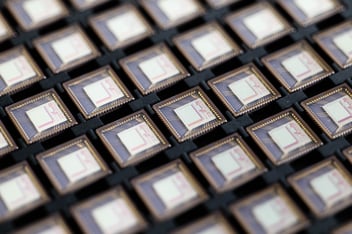Finger Vein Authentication with SWIR Image Sensor
Security measures to ensure our most vulnerable devices, including smartphones and laptops need to be drastically improved. We have seen a drastic increase in smartphone thefts, the Federal Communications Commission, stating that “1 in 10 US smartphone owners are victims of phone theft.” To safeguard our most private information if our smart phone device is stolen, there should be new security features to prevent unwanted access to our devices. Biometrics has become the new normal to unlock our devices, the two methods are either using our face or finger to unlock our phones. But when lighting or angles affect the camera’s ability to identify our biometrics to unlock our device, we can use a backup method like a passcode to unlock the phone, that is when thieves are able to use software to unlock the device. With technology advancing so have the methods thieves use to hack into devices. With a new security feature like finger vein authentication, it would make it difficult for thieves to be able to access devices because finger veins cannot be replicated.
Finger vein authentication is a new secure measure to prevent thieves from accessing our stolen devices. The use of fingerprint scanning has already been established in smartphones and tablets to prevent unwanted users from unlocking our devices. This technology includes the use of image sensors to scan the fingerprint that is resting on the display to compare with the fingerprint that was scanned into the device that is associated with the owner.

SWIR imagery for finger vein mapping. Courtesy of SeeDevice’s QMOS™ image sensor.
Replacing the current image sensor used for fingerprint scanning with a SWIR (shortwave infrared) image sensor will enable finger vein authentication. The way in which this technology is possible is by the SWIR sensor’s ability to view past the dermis layer to view the veins below. SWIR wavelengths are capable of piercing through different material types due to the light’s size and inability to scatter. The light that is either absorbed or reflected provides the image sensor with the data needed to produce an image of the user’s finger vein. Every finger vein is unique which makes it impossible to be replicated. This would not only safeguard smart devices, but applications that utilize biometrics as part of their sign-in process as well. Many applications have already integrated biometrics into their sign-in process but requiring finger vein authentication provides an additional security measure in the case a user’s device was stolen to prevent the thief from accessing the user’s financial information and other sensitive information. SeeDevice has the ability for such technologies to be available with the use of the QMOS™ sensor. With the sensor’s low price point and scalability, it would be very easy for this technology to be mass produced and be widely available in numerous products.
About SeeDevice Inc.
SeeDevice is a fabless image sensor development company empowering the next generation of smart devices with its patented QMOS™ (Quantum effect CMOS) SWIR image sensor. SeeDevice’s sensor can send high-fidelity image data to AI vision systems and monitoring devices. QMOS™ delivers an industry-leading ultra-wide spectral range and among the highest infrared sensitivity by using innovative quantum pixel technology to advance CMOS process sensors.


.png?width=352&name=chip%20grid%20photo%20edited%20for%20banner%20-%20Copy%20(2).png)
